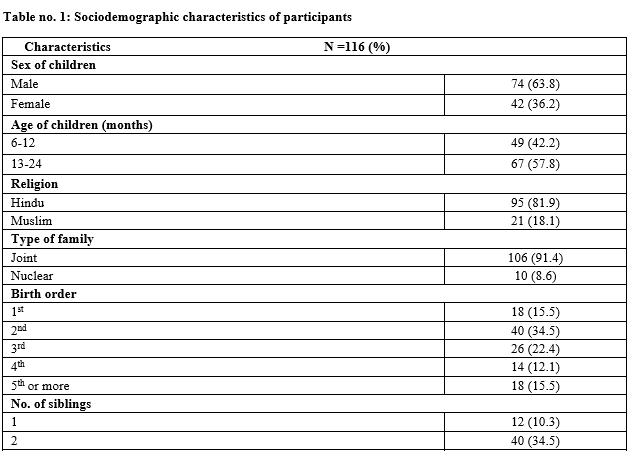Knowledge, attitudes and practices regarding infant feeding among mothers of children with severe acute malnutrition in the rural areas of Northern India
Abstract
Introduction: Malnutrition has been identified as one of the principal causes limiting India’s global economic potential. The infant and young child-feeding practices determine the nutritional status, growth and ultimately the survival of infants and young children. The study aimed to assess the knowledge, attitude and practices of rural mothers with children diagnosed with severe acute malnutrition (SAM) regarding infant feeding.
Methodology: A hospital-based cross-sectional descriptive study on 116 mothers from the rural area of Northern India with children diagnosed with SAM. Assessment of knowledge, attitude and practice of mothers regarding infant feeding was done through face to face interviews using a structured questionnaire containing 32 questions.
Results: The mean age of admitted children was 14.48 ± 4.71 months. The majority of mothers (81.9%) studied till only primary school or were illiterate. The appropriate knowledge about early initiation of breastfeeding and the ideal time to start complementary feeding was found in 42.4% and 45.6% of mothers respectively which was suboptimal. The attitude towards ideal breastfeeding practices was positive in most mothers. However in practice only 59.4% of mothers exclusively breastfed their babies till 6 months and 54.3% delayed initiation of complementary feed beyond 9 months of age. The frequency of complementary feeding was inadequate in the 6-8 months age group as stated by 88.6% of mothers and minimum dietary diversity was not followed by 68.1% of mothers.
Conclusion: The knowledge and positive attitude towards infant feeding are not applied in practice by mothers. Efforts should be made to improve knowledge, attitude and practice with an emphasis on complementary feeding indicators to reduce the burden of malnutrition in the rural population.
Downloads
References
2. Institute for Health Metrics and Evaluation GBD Compare data visualization, University of Washington, Seattle http://vizhub.healthdata.org/gbd-compare
3. Comprehensive National Nutrition Survey (CNNS) National Report, Ministry of Health and Family Welfare (MoHFW), Government of India, UNICEF and Population Council. 2019
4. Improving Child Nutrition. The achievable imperative for global progress. New York: United Nations Children's Fund (UNICEF); c 2013. Available from: www.unicef.org/publications/index.html.
5. Victora CG, Adair L, Fall C, Hallal PC, Martorell R, Richter L, Sachdev HS, for the Maternal and Child Undernutrition Study Group Maternal and child undernutrition 2: consequences for adult health and human capital. Lancet. 2008;371(9609):340-57.
https://doi.org/10.1016/S0140-6736(07)61692-4
6. Scaglioni, S., De Cosmi, V., Ciappolino, V., Parazzini, F., Brambilla, P., & Agostoni, C. (2018). Factors Influencing Children's Eating Behaviours. Nutrients, 10(6), 706
https://doi.org/10.3390/nu10060706
7. WHO child growth standards and the identification of severe acute malnutrition in infants and children. A joint statement by the WHO and the United Nations Children's Fund.Geneva: World Health Organization; 2009.
8. WHO/UNICEF/IFPRI/UCDavis/FANTA/AED/USAID. Indicators for Assessing Infant and Young Child Feeding Practices. Part 2. Measurement. Geneva: World Health Organization; 2008. Available from: http://www.who.int
9. Global strategy for infant and young child feeding. Geneva: World Health Organization, 2003. http:// www.who.int/child-adolescent-health/ New_Publications/NUTRITION/gs_iycf.pdf
10.Agarwal S, Srivastava K, Sethi V. Maternal and New-born Care Practices Among the Urban Poor in Indore, India: Gaps, Reasons and Possible Program Options. Urban Health Resource Center, New Delhi, 2007.
https://doi.org/10.2139/ssrn.2810871
11. Patel A, Badhoniya N, Khadse S, Senarath U, Agho KE, Dibley MJ, et al. Infant and young child feeding indicators and determinants of poor feeding practices in India: secondary data analysis of National Family Health Survey 2005-06. Food Nutr Bull 2010;31(2):314-333.
https://doi.org/10.1177/156482651003100221
12.Ali S, Ali SF, Imam AM, Ayub S, Billoo AG. Perception and practices of breastfeeding of infants 0-6 months in an urban and a semi-urban community in Pakistan: a cross-sectional study. J Pak Med Assoc 2011;61(1):99-104.
13.Rahman M, Haque SE, Zahan S, Islam O. Noninstitutional births and newborn care practices among adolescent mothers in Bangladesh. J Obstet Gynecol Neonatal Nurs 2011;40(3):262-273.
https://doi.org/10.1111/j.1552-6909.2011.01240.x
14.Subedi N, Paudel S, Rana T, Poudyal AK. Infant and young child feeding practices in Chepang communities. J Nepal Health Res Counc 2012;10(21):141-146.PubMed PMID: 23034377.
16. Ministry of Health and Family Welfare. Government of India. National Family Health Survey - 4, 2015 -16. District Level Household Survey. Available at http://rchiips.org/nfhs/FCTS/RJ/RJ_FactSheet_130_
17. Daly SE, Hartmann PE. Infant demand and milk supply. Part 1: infant demand and milk production in lactating women. J Hum Lact. 1995;11(1):21-6.
https://doi.org/10.1177/089033449501100119
18. Sharma, U., Yadav, N., Rachana Mishra, S., & Tiwari, P. (2015). Demographic and socio-economic correlates of acute undernutrition in the pre-school children of Allahabad, North India. International Journal of Current Research and Review, 7(1), 9-12.
19. Breastfeeding up to two years of age or beyond and its influence on child growth and development: a systematic reviewCad. Saúde Pública 29 (2) • Feb 2013
https://doi.org/10.1590/S0102-311X2013000200012
20. Prerna Singhal, S.K. Garg, H. Chopra, Seema Jain, S.K. Bajpai, Arun Kumar Status of Infant and Young Child Feeding Practices with Special Emphasis on Breast Feeding in an Urban Area of Meerut IOSR Journal of Dental and Medical Sciences (IOSR-JDMS) e-ISSN: 2279-0853, p-ISSN: 2279-0861,May. - Jun. 2013
https://doi.org/10.9790/0853-0740711
21. Sukes Das, Nivedita Das, Malay Mundle and Palash Das A study on Infant and Young Child Feeding (IYCF) practices among mothers attending a Tertiary Health Care Institution, Kolkata Al Ameen J Med Sci 2018; 11(3): 172-177
22. Arimond M, Ruel MT. Dietary diversity is associated with child nutritional status: evidence from 11 demographic and health surveys. J Nutr. 2004 Oct;134(10):2579-85
https://doi.org/10.1093/jn/134.10.2579
23.Agrawal, S., Kim, R., Gausman, J. et al. Socio-economic patterning of food consumption and dietary diversity among Indian children: evidence from NFHS-4. Eur J Clin Nutr 73, 1361-1372 (2019)
https://doi.org/10.1038/s41430-019-0406-0

Copyright (c) 2021 Author (s). Published by Siddharth Health Research and Social Welfare Society

This work is licensed under a Creative Commons Attribution 4.0 International License.


 OAI - Open Archives Initiative
OAI - Open Archives Initiative


